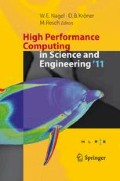Abstract
The γ-Re θ -model, a two equation, correlation-based transition model using local variables, has been employed to predict the extension of the laminar regions on a stiff geometry of the common dolphin (delphinus delphis) moving in the Reynolds regime of 5.5⋅105 to 107. Mesh independence was gained for a domain resolution of approximately 30 million cells in an unstructured polyhedral mesh with a prismatic wall region (y +≈1). The final results conclude with very limited laminar regions and thus a mainly turbulent flow around the body of a dolphin traveling at the usual speed of 3 m/s and a resulting drag coefficient of C D ≈0.004 referring to the wetted surface area of A=1.571 m2. Consequently the potential for active laminarization due to the anisotropic structure of the dolphin skin is well established and is estimated to be as high as 20% with respect to drag force reduction.
Access this chapter
Tax calculation will be finalised at checkout
Purchases are for personal use only
Preview
Unable to display preview. Download preview PDF.
References
B. J. Abu-Ghannam and R. Shaw. Natural transition of boundary layers—the effects of turbulence, pressure gradient and flow history. Journal Mechanical Engineering Science, 22 (5): 213–228, 1980.
I. Demirdzic and S. Muzaferija. Numerical method for coupled fluid flow, heat transfer and stress analysis using unstructured moving meshes with cells of arbitrary topology. Computer Methods in Applied Mechanics and Engineering, 125 (1–4): 235–255, 1995.
F. E. Fish. The myth and reality of gray’s paradox: Implication of dolphin drag reduction for technology. Bioinspiration & Biomimetics, 1 (2): R17–R25, 2006.
J. Gray. Studies in animal locomotion: VI. The propulsive powers of the dolphin. Journal of Experimental Biology, 13: 192–199, 1936.
R. B. Langtry. A Correlation-Based Transition Model using Local Variables for Unstructured Parallelized CFD codes. PhD thesis, Universität Stuttgart, 2006.
R. B. Langtry and F. R. Menter. Correlation-based transition modeling for unstructured parallelized computational fluid dynamics codes. AIAA Journal, 47 (12): 2894–2906, December 2009.
P. Malan, K. Suluksna, and E. Juntasaro. Calibrating the γ-Re θ transition model. In ERCOFTAC Bulletin 80, pages 53–57.
P. Malan, K. Suluksna, and E. Juntasaro. Calibrating the γ-Re θ transition model for commercial cfd. In 47th AIAA Aerospace Sciences Meeting, January 2009.
F. R. Menter. Two-equation eddy-viscosity turbulence models for engineering applications. AIAA Journal, 32 (8): 1598–1605, August 1994.
F. R. Menter, R. B. Langtry, S. R. Likki, Y. B. Suzen, P. G. Huang, and S. Völker. A correlation-based transition model using local variables – Part I: Model foundation. Journal of Turbomachinery, 128: 413–422, July 2006.
F. R. Menter, R. B. Langtry, S. R. Likki, Y. B. Suzen, P. G. Huang, and S. Völker. A correlation-based transition model using local variables – Part II: Test cases and industrial applications. Journal of Turbomachinery, 128: 423–434, July 2006.
V. V. Pavlov. Dolphin skin as a natural anisotropic compliant wall. Institute of Physics Publishing: Bioinspiration & Biomimetics, 1: 31–40, 2006.
K. Suluksna, P. Dechaumphai, and E. Juntasaro. Correlations for modeling transitional boundary layers under influences of freestream turbulence and pressure gradient. International Journal of Heat and Fluid Flow, 30: 66–75, 2009.
F. M. White. Viscous Fluid Flow. McGraw-Hill Series in Mechanical Engineering, 2 edition, 1991.
Author information
Authors and Affiliations
Corresponding author
Editor information
Editors and Affiliations
Rights and permissions
Copyright information
© 2012 Springer-Verlag Berlin Heidelberg
About this paper
Cite this paper
Riedeberger, D., Rist, U. (2012). Numerical Simulation of Laminar-Turbulent Transition on a Dolphin Using the γ-Re θ Model. In: Nagel, W., Kröner, D., Resch, M. (eds) High Performance Computing in Science and Engineering '11. Springer, Berlin, Heidelberg. https://doi.org/10.1007/978-3-642-23869-7_28
Download citation
DOI: https://doi.org/10.1007/978-3-642-23869-7_28
Publisher Name: Springer, Berlin, Heidelberg
Print ISBN: 978-3-642-23868-0
Online ISBN: 978-3-642-23869-7
eBook Packages: Mathematics and StatisticsMathematics and Statistics (R0)

